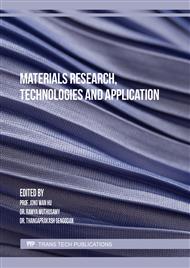[1]
R.W. August, Nanofiber air filters can even stop a virus from getting through, 2015 Available in: https://ninithi.wordpress.com/2015/08/15/nanofiber-air-filters-can-even-stop-a-virus-from-getting-through/.
Google Scholar
[2]
V. V. Kadam, L. Wang, R. Padhye, Electrospun nanofibre materials to filter air pollutants – A review, J. Ind. Text., 47 (8) (2018) 2253–2280.
DOI: 10.1177/1528083716676812
Google Scholar
[3]
M. Zhu, J. Han, F. Wang, et al., Electrospun Nanofibers Membranes for Effective Air Filtration, Macromol. Mater. Eng., 302 (1) (2017) 1–27.
Google Scholar
[4]
Z. M. Huang, Y. Z. Zhang, M. Kotaki, S. Ramakrishna, A review on polymer nanofibers by electrospinning and their applications in nanocomposites, Compos. Sci. Technol., 63 (15) 92003) 2223–2253.
DOI: 10.1016/s0266-3538(03)00178-7
Google Scholar
[5]
N. Wang, A. Raza, Y. Si, J. Yu, G. Sun, B. Ding, Tortuously structured polyvinyl chloride/polyurethane fibrous membranes for high-efficiency fine particulate filtration, J. Colloid Interface Sci., 398 (2013) 240–246.
DOI: 10.1016/j.jcis.2013.02.019
Google Scholar
[6]
R. S. Barhate and S. Ramakrishna, Nanofibrous filtering media: filtration problems and solutions from tiny materials, J. Memb. Sci., 296 (1–2) (2007) 1–8.
DOI: 10.1016/j.memsci.2007.03.038
Google Scholar
[7]
K. Desai, K. Kit, J. Li, P. Michael Davidson, S. Zivanovic, H. Meyer, Nanofibrous chitosan non-wovens for filtration applications, Polymer, 50 (15) (2009) 3661–3669.
DOI: 10.1016/j.polymer.2009.05.058
Google Scholar
[8]
A. Aluigi, C. Vineis, C. Tonin, C. Tonetti, A. Varesano, G. Mazzuchetti, Wool keratin-based nanofibres for active filtration of air and water, J. Biobased Mater. Bioenergy, 3 (3) (2009) 311–319.
DOI: 10.1166/jbmb.2009.1039
Google Scholar
[9]
Y. Bian, R. Wang, S. H. Ting, C. Chen, L. Zhang, Electrospun SF/PVA Nanofiber Filters for Highly Efficient PM2.5 Capture, IEEE Trans. Nanotechnol., 17 (5) (2018) 934–939.
DOI: 10.1109/tnano.2018.2824343
Google Scholar
[10]
Q. Zhang, Q. Li, T. M. Young, D. P. Harper, S. Wang, A Novel Method for Fabricating an Electrospun Poly(Vinyl Alcohol)/Cellulose Nanocrystals Composite Nanofibrous Filter with Low Air Resistance for High-Efficiency Filtration of Particulate Matter, ACS Sustain. Chem. Eng., 7 (9) (2019) 8706–8714.
DOI: 10.1021/acssuschemeng.9b00605
Google Scholar
[11]
H. Shalihah, A. Kusumaatmaja, A. D. Nugraheni, and K. Triyana, Optimization of chitosan/PVA concentration in fabricating nanofibers membrane and its prospect as air filtration, Mater. Sci. Forum, 901 (2017) 20–25.
DOI: 10.4028/www.scientific.net/msf.901.20
Google Scholar
[12]
A. Kusumaatmaja, B. Sukandaru, Chotimah, K. Triyana, Application of polyvinyl alcohol nanofiber membrane for smoke filtration, AIP Conf. Proc., 1755 (2016) 1-6.
DOI: 10.1063/1.4958579
Google Scholar
[13]
L. Zhang, L. Li, L. Wang, J. Nie, G. Ma, Multilayer electrospun nanofibrous membranes with antibacterial property for air filtration, Appl. Surf. Sci., 515 (2020) 145962-145972.
DOI: 10.1016/j.apsusc.2020.145962
Google Scholar
[14]
C. Lou, M. Lin, C. Huang, M. Lai, B. Shiu, J. Lin, Preparation of Needleless Electrospinning Polyvinyl Membranes : Antibacterial Property and Filter Efficiency, Polymers, 14 (2022) 1054-1069.
DOI: 10.3390/polym14051054
Google Scholar
[15]
Y. F. Xing, Y. H. Xu, M. H. Shi, Y. X. Lian, The impact of PM2.5 on the human respiratory system, J. Thorac. Dis., 8 (1) (2016) E69–E74.
Google Scholar
[16]
S. Zhu, H. Yu, Y. Chen, M. Zhu, Study on the morphologies and formational mechanism of Poly(hydroxybutyrate-co-hydroxy valerate) ultrafine fibers by dry-jet-wet-electrospinning, J. Nanomater., 2012 (2012) 1-8.
DOI: 10.1155/2012/525419
Google Scholar
[17]
A. Haider, S. Haider, I. K. Kang, A comprehensive review summarizing the effect of electrospinning parameters and potential applications of nanofibers in biomedical and biotechnology, Arab. J. Chem., 11 (8) (2018) 1165–1188.
DOI: 10.1016/j.arabjc.2015.11.015
Google Scholar
[18]
B. Tarus, N. Fadel, A. Al-Oufy, M. El-Messiry, Effect of polymer concentration on the morphology and mechanical characteristics of electrospun cellulose acetate and poly (vinyl chloride) nanofiber mats, Alexandria Eng. J., 55 (3) (2016) 2975–2984.
DOI: 10.1016/j.aej.2016.04.025
Google Scholar
[19]
S. Nokhasteh, A. M. Molavi, M. Khorsand-Ghayeni, A. Sadhegi-Avalshahr, Preparation of PVA/Chitosan samples by electrospinning and film casting methods and evaluating the effect of surface morphology on their antibacterial behavior, Mater. Res. Express., 7 (2020) 015401–015410.
DOI: 10.1088/2053-1591/ab572c
Google Scholar



